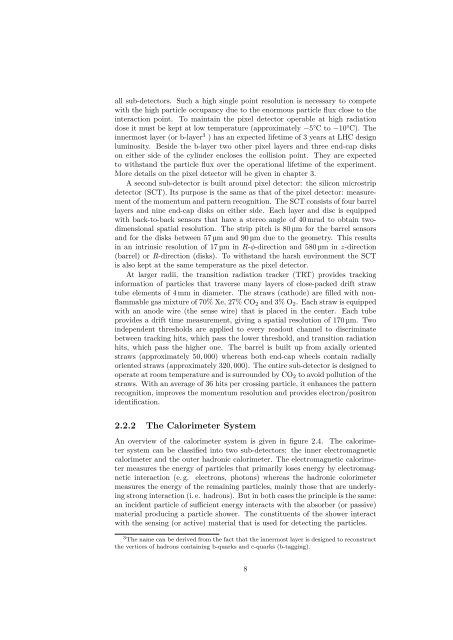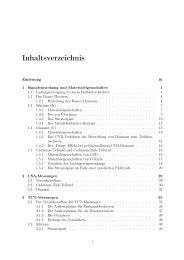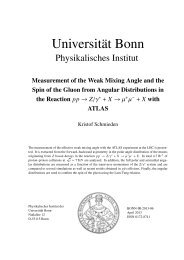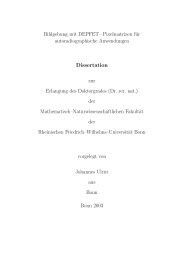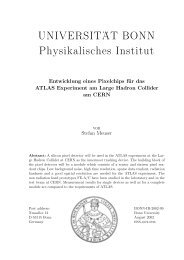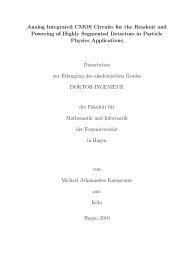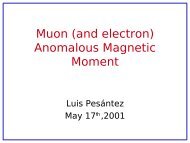Jens Janssen Diploma Thesis - Prof. Dr. Norbert Wermes ...
Jens Janssen Diploma Thesis - Prof. Dr. Norbert Wermes ...
Jens Janssen Diploma Thesis - Prof. Dr. Norbert Wermes ...
You also want an ePaper? Increase the reach of your titles
YUMPU automatically turns print PDFs into web optimized ePapers that Google loves.
all sub-detectors. Such a high single point resolution is necessary to competewith the high particle occupancy due to the enormous particle flux close to theinteraction point. To maintain the pixel detector operable at high radiationdose it must be kept at low temperature (approximately ≠5°C to≠10°C). Theinnermost layer (or b-layer 3 ) has an expected lifetime of 3 years at LHC designluminosity. Beside the b-layer two other pixel layers and three end-cap diskson either side of the cylinder encloses the collision point. They are expectedto withstand the particle flux over the operational lifetime of the experiment.More details on the pixel detector will be given in chapter 3.A second sub-detector is built around pixel detector: the silicon microstripdetector (SCT). Its purpose is the same as that of the pixel detector: measurementof the momentum and pattern recognition. The SCT consists of four barrellayers and nine end-cap disks on either side. Each layer and disc is equippedwith back-to-back sensors that have a stereo angle of 40 mrad to obtain twodimensionalspatial resolution. The strip pitch is 80 µm for the barrel sensorsand for the disks between 57 µm and 90 µm due to the geometry. This resultsin an intrinsic resolution of 17 µm inR-„-direction and 580 µm inz-direction(barrel) or R-direction (disks). To withstand the harsh environment the SCTis also kept at the same temperature as the pixel detector.At larger radii, the transition radiation tracker (TRT) provides trackinginformation of particles that traverse many layers of close-packed drift strawtube elements of 4mm in diameter. The straws (cathode) are filled with nonflammablegas mixture of 70% Xe, 27% CO 2 and 3% O 2 . Each straw is equippedwith an anode wire (the sense wire) that is placed in the center. Each tubeprovides a drift time measurement, giving a spatial resolution of 170 µm. Twoindependent thresholds are applied to every readout channel to discriminatebetween tracking hits, which pass the lower threshold, and transition radiationhits, which pass the higher one. The barrel is built up from axially orientedstraws (approximately 50, 000) whereas both end-cap wheels contain radiallyoriented straws (approximately 320, 000). The entire sub-detector is designed tooperate at room temperature and is surrounded by CO 2 to avoid pollution of thestraws. With an average of 36 hits per crossing particle, it enhances the patternrecognition, improves the momentum resolution and provides electron/positronidentification.2.2.2 The Calorimeter SystemAn overview of the calorimeter system is given in figure 2.4. The calorimetersystem can be classified into two sub-detectors: the inner electromagneticcalorimeter and the outer hadronic calorimeter. The electromagnetic calorimetermeasures the energy of particles that primarily loses energy by electromagneticinteraction (e. g. electrons, photons) whereas the hadronic colorimetermeasures the energy of the remaining particles, mainly those that are underlyingstrong interaction (i. e. hadrons). But in both cases the principle is the same:an incident particle of su cient energy interacts with the absorber (or passive)material producing a particle shower. The constituents of the shower interactwith the sensing (or active) material that is used for detecting the particles.3 The name can be derived from the fact that the innermost layer is designed to reconstructthe vertices of hadrons containing b-quarks and c-quarks (b-tagging).8


